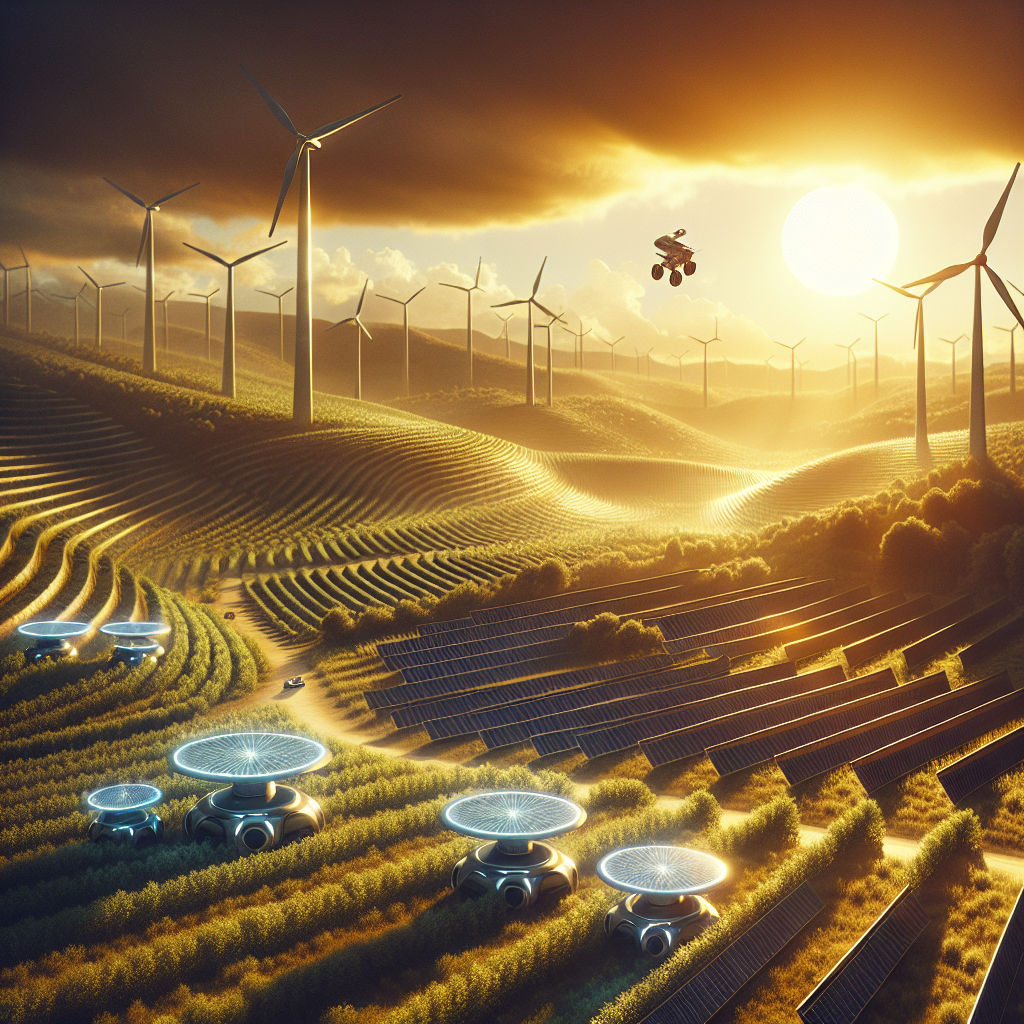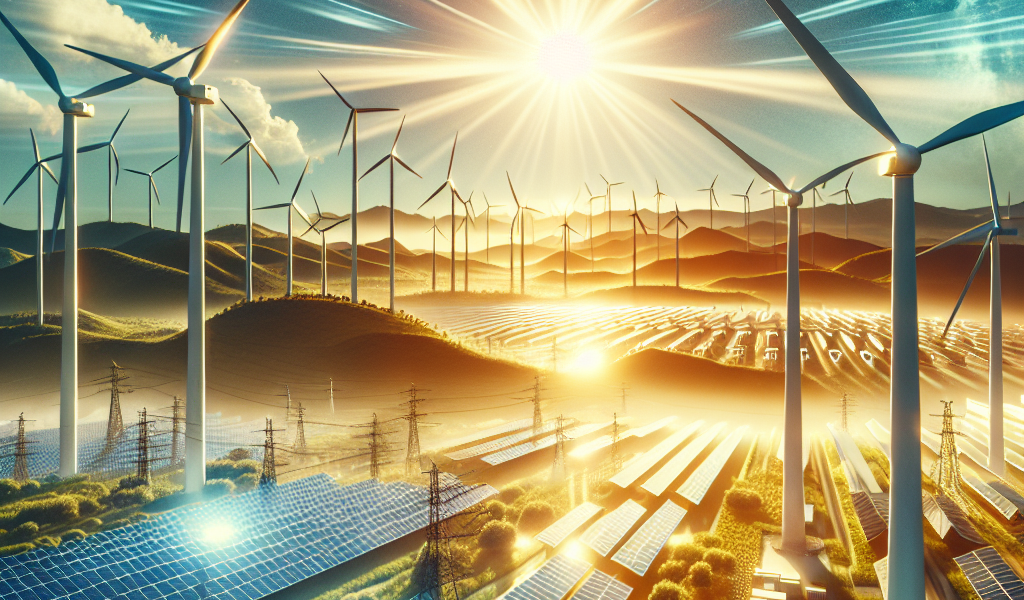-
Table of Contents
“Empowering Tomorrow: Breakthroughs in Solar and Wind Energy”
Introduction

The future of renewable energy is poised for transformative advancements, particularly in the realms of solar and wind power. As the global community grapples with the pressing need to mitigate climate change and reduce dependency on fossil fuels, innovative technologies and strategies are emerging to harness the full potential of these abundant natural resources. Solar power is witnessing breakthroughs in photovoltaic efficiency, energy storage solutions, and integration with smart grid systems, while wind power is benefiting from advancements in turbine design, offshore wind farms, and predictive maintenance technologies. Together, these innovations are not only enhancing the efficiency and reliability of renewable energy sources but also making them more accessible and cost-effective. This dynamic evolution promises to play a pivotal role in shaping a sustainable and resilient energy future.
Advances In Solar Panel Efficiency: Breaking New Ground
The future of renewable energy is increasingly becoming a focal point of global discussions, with solar and wind power leading the charge. As the world grapples with the pressing need to reduce carbon emissions and combat climate change, advancements in solar panel efficiency are breaking new ground, offering promising solutions to meet the growing energy demands sustainably. These innovations are not only enhancing the performance of solar panels but also making them more accessible and cost-effective for widespread adoption.
One of the most significant breakthroughs in solar technology is the development of perovskite solar cells. Unlike traditional silicon-based cells, perovskite cells are made from a variety of materials that can be manufactured at lower temperatures, reducing production costs. Moreover, perovskite cells have demonstrated remarkable efficiency rates, with some laboratory tests achieving over 25% efficiency. This is a substantial improvement compared to the average 15-20% efficiency of conventional silicon panels. The potential for perovskite cells to be integrated into flexible and lightweight materials further expands their application possibilities, from building-integrated photovoltaics to portable solar chargers.
In addition to perovskite cells, tandem solar cells are another area where significant progress is being made. Tandem cells combine two or more layers of different photovoltaic materials to capture a broader spectrum of sunlight. By stacking these layers, tandem cells can achieve higher efficiency rates than single-junction cells. Recent advancements have seen tandem cells reach efficiency levels exceeding 30%, a milestone that could revolutionize the solar industry. The integration of tandem cells into existing solar panel designs is expected to enhance overall energy output, making solar power a more viable option for large-scale energy production.
Furthermore, the advent of bifacial solar panels is contributing to the efficiency revolution. Unlike traditional panels that only capture sunlight from one side, bifacial panels can absorb light from both the front and back surfaces. This dual-sided absorption allows for increased energy generation, particularly in environments with high albedo, such as snowy or sandy areas. Bifacial panels can potentially boost energy yields by up to 30%, making them an attractive option for solar farms and rooftop installations alike.
Another promising innovation is the use of artificial intelligence (AI) and machine learning to optimize solar panel performance. AI algorithms can analyze vast amounts of data from solar installations to predict and enhance energy output. By monitoring factors such as weather conditions, shading, and panel orientation, AI can dynamically adjust the system to maximize efficiency. This intelligent management of solar resources not only improves performance but also extends the lifespan of the panels, ensuring a more sustainable investment.
Moreover, advancements in energy storage solutions are complementing the improvements in solar panel efficiency. High-capacity batteries and other storage technologies are crucial for addressing the intermittent nature of solar power. By storing excess energy generated during peak sunlight hours, these systems ensure a steady supply of electricity even when the sun is not shining. The integration of efficient storage solutions with advanced solar panels is paving the way for a more reliable and resilient renewable energy infrastructure.
In conclusion, the future of renewable energy is being shaped by groundbreaking advancements in solar panel efficiency. Innovations such as perovskite and tandem cells, bifacial panels, and AI-driven optimization are setting new benchmarks for performance and cost-effectiveness. As these technologies continue to evolve, they hold the promise of making solar power a cornerstone of the global energy landscape, driving us towards a more sustainable and environmentally friendly future.
Offshore Wind Farms: Harnessing Oceanic Power
Offshore wind farms are emerging as a pivotal component in the global transition to renewable energy, harnessing the immense power of oceanic winds to generate electricity. As the world grapples with the pressing need to reduce carbon emissions and combat climate change, the development of offshore wind technology represents a significant stride towards a sustainable energy future. This innovative approach leverages the vast, untapped potential of wind resources over the open seas, offering a promising solution to the growing demand for clean energy.
One of the primary advantages of offshore wind farms is their ability to capture stronger and more consistent winds compared to their onshore counterparts. The open ocean provides an unobstructed path for wind currents, resulting in higher wind speeds and, consequently, greater energy output. This efficiency is further enhanced by the ability to deploy larger turbines offshore, where space constraints are less of an issue. These larger turbines can generate more electricity, making offshore wind farms a highly effective means of producing renewable energy on a large scale.
Moreover, the location of offshore wind farms away from populated areas mitigates some of the common concerns associated with onshore wind farms, such as noise pollution and visual impact. This geographical separation not only addresses aesthetic and environmental concerns but also opens up vast new areas for energy development that would otherwise be unavailable. As a result, offshore wind farms can contribute significantly to the energy grid without encroaching on valuable land resources or disrupting local communities.
Technological advancements are playing a crucial role in the expansion and efficiency of offshore wind farms. Innovations in turbine design, such as floating wind turbines, are enabling the deployment of wind farms in deeper waters where traditional fixed-bottom turbines are not feasible. These floating turbines are anchored to the seabed using mooring lines, allowing them to operate in areas with greater wind potential. Additionally, improvements in materials and construction techniques are enhancing the durability and longevity of offshore wind installations, ensuring they can withstand harsh marine environments and continue to generate power reliably over extended periods.
The economic implications of offshore wind farms are also noteworthy. The development and maintenance of these installations create numerous job opportunities, from engineering and construction to operations and maintenance. Furthermore, the growth of the offshore wind industry can stimulate local economies by attracting investment and fostering the development of related industries, such as manufacturing and supply chain logistics. As countries around the world invest in renewable energy infrastructure, offshore wind farms are poised to become a significant driver of economic growth and job creation.
However, the expansion of offshore wind farms is not without its challenges. The high initial costs of installation and the complexities of operating in marine environments can pose significant barriers to entry. Additionally, there are environmental considerations to address, such as the potential impact on marine ecosystems and wildlife. To mitigate these concerns, ongoing research and development are essential to refine technologies and practices that minimize environmental disruption while maximizing energy output.
In conclusion, offshore wind farms represent a transformative approach to harnessing renewable energy from the ocean. By capitalizing on the powerful and consistent winds over the seas, these installations offer a highly efficient and sustainable solution to the world’s growing energy needs. With continued technological advancements and strategic investments, offshore wind farms have the potential to play a central role in the global transition to a cleaner, more sustainable energy future. As we navigate the challenges and opportunities of this burgeoning industry, the promise of harnessing oceanic power through offshore wind farms remains a beacon of hope for a greener planet.
Solar Energy Storage Solutions: The Next Frontier
As the world grapples with the pressing need to transition from fossil fuels to renewable energy sources, solar power has emerged as a leading contender in the quest for sustainable energy solutions. However, one of the most significant challenges facing the widespread adoption of solar energy is the issue of storage. The sun does not shine around the clock, and cloudy days can significantly reduce solar power generation. Consequently, the development of efficient and reliable solar energy storage solutions has become the next frontier in the renewable energy sector.
In recent years, advancements in battery technology have shown promise in addressing the intermittency of solar power. Lithium-ion batteries, which are already widely used in electric vehicles and portable electronics, have been adapted for use in solar energy storage systems. These batteries offer high energy density, long cycle life, and relatively low self-discharge rates, making them a viable option for storing solar energy. Companies like Tesla have made significant strides in this area with products like the Powerwall, which allows homeowners to store excess solar energy generated during the day for use at night or during power outages.
Despite these advancements, lithium-ion batteries are not without their limitations. They are expensive to produce, and their performance can degrade over time. Additionally, the extraction of lithium and other materials used in these batteries raises environmental and ethical concerns. As a result, researchers are exploring alternative storage technologies that could offer more sustainable and cost-effective solutions.
One such alternative is the development of solid-state batteries. Unlike traditional lithium-ion batteries, which use liquid electrolytes, solid-state batteries employ solid electrolytes. This design offers several advantages, including higher energy density, improved safety, and longer lifespan. Companies like Toyota and QuantumScape are at the forefront of this research, aiming to bring solid-state batteries to market within the next few years. If successful, these batteries could revolutionize solar energy storage by providing a more efficient and durable solution.
Another promising area of research is the use of flow batteries for solar energy storage. Flow batteries store energy in liquid electrolytes contained in external tanks, allowing for easy scalability and long-duration storage. Vanadium redox flow batteries, in particular, have garnered attention for their ability to provide stable and reliable energy storage over extended periods. While still in the early stages of development, flow batteries have the potential to complement existing storage technologies and provide a more flexible solution for large-scale solar energy storage.
In addition to advancements in battery technology, researchers are also exploring innovative ways to integrate solar energy storage with other renewable energy sources. For instance, hybrid systems that combine solar power with wind energy can help mitigate the intermittency of both sources. By storing excess energy generated by solar panels and wind turbines in a shared storage system, these hybrid solutions can provide a more consistent and reliable power supply.
Moreover, the development of smart grid technology is playing a crucial role in optimizing solar energy storage. Smart grids use advanced sensors, communication networks, and data analytics to monitor and manage energy production, storage, and consumption in real-time. This allows for more efficient use of stored solar energy and helps balance supply and demand across the grid. As smart grid technology continues to evolve, it will enable more seamless integration of solar energy storage solutions into the broader energy infrastructure.
In conclusion, the future of renewable energy hinges on the ability to develop effective solar energy storage solutions. While significant progress has been made with lithium-ion batteries, ongoing research into solid-state batteries, flow batteries, and hybrid systems holds the promise of even greater advancements. Coupled with the implementation of smart grid technology, these innovations will be instrumental in overcoming the challenges of solar energy storage and paving the way for a more sustainable and resilient energy future.
Smart Grids And Renewable Integration: A Seamless Future
As the world grapples with the pressing need to transition from fossil fuels to cleaner energy sources, the integration of renewable energy into the existing power grid has become a focal point of innovation. Solar and wind power, two of the most promising renewable energy sources, are at the forefront of this transformation. However, their intermittent nature poses significant challenges for grid stability and reliability. This is where smart grids come into play, offering a seamless future for renewable integration.
Smart grids are advanced electrical grids that use digital communication technology to detect and react to local changes in usage. They are designed to improve the efficiency, reliability, and sustainability of electricity services. By incorporating real-time data and automated control systems, smart grids can effectively manage the variable output from solar and wind power sources. This capability is crucial for maintaining a balanced supply and demand, thereby ensuring a stable energy supply.
One of the key innovations in smart grid technology is the development of advanced energy storage systems. These systems can store excess energy generated during periods of high solar and wind activity and release it when production is low. This not only helps in smoothing out the fluctuations in energy supply but also enhances the overall efficiency of the grid. For instance, lithium-ion batteries, which have seen significant advancements in recent years, are now capable of storing large amounts of energy for extended periods. This makes them an ideal solution for balancing the intermittent nature of renewable energy sources.
Moreover, smart grids facilitate better demand response strategies. By using real-time data, utilities can predict periods of high demand and adjust the supply accordingly. This is particularly beneficial for integrating renewable energy, as it allows for more flexible and dynamic management of energy resources. For example, during a sunny day with high solar power generation, smart grids can signal consumers to use more electricity, thereby preventing the wastage of excess energy. Conversely, during periods of low renewable output, the grid can encourage consumers to reduce their usage, thus maintaining a balanced system.
Another significant aspect of smart grids is their ability to support distributed generation. Unlike traditional power grids, which rely on centralized power plants, smart grids can integrate multiple small-scale renewable energy sources. This decentralization not only enhances the resilience of the grid but also promotes the use of local renewable resources. For instance, rooftop solar panels and small wind turbines can be connected to the smart grid, allowing homeowners and businesses to generate their own electricity and contribute to the overall energy supply.
Furthermore, the integration of artificial intelligence (AI) and machine learning into smart grids is revolutionizing the way renewable energy is managed. AI algorithms can analyze vast amounts of data from various sources, including weather forecasts, energy consumption patterns, and grid conditions, to optimize the operation of the grid. This enables more accurate predictions of renewable energy generation and more efficient allocation of resources. As a result, the grid becomes more adaptive and capable of handling the complexities associated with renewable energy integration.
In conclusion, the future of renewable energy lies in the seamless integration of solar and wind power into smart grids. Through advanced energy storage systems, better demand response strategies, support for distributed generation, and the incorporation of AI, smart grids are paving the way for a more sustainable and reliable energy future. As these technologies continue to evolve, they will play a crucial role in overcoming the challenges associated with renewable energy and ensuring a stable and efficient power supply for generations to come.
Conclusion
The future of renewable energy, particularly in solar and wind power, is promising due to continuous technological advancements and decreasing costs. Innovations such as more efficient photovoltaic cells, improved energy storage solutions, and advanced wind turbine designs are driving increased adoption and integration into the global energy grid. These developments are crucial for reducing greenhouse gas emissions and combating climate change, positioning renewable energy as a cornerstone of sustainable development. As investment and research in these technologies continue to grow, solar and wind power are expected to play a dominant role in the global energy landscape, ensuring a cleaner and more resilient energy future.





